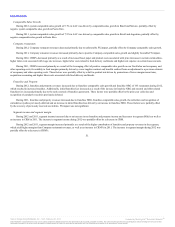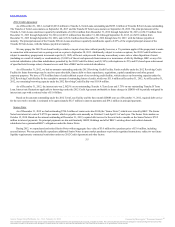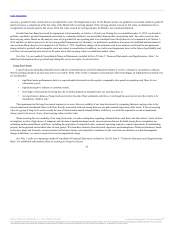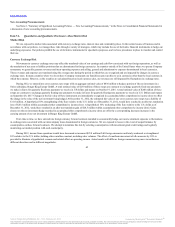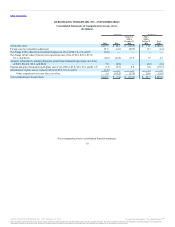Burger King 2012 Annual Report Download - page 61
Download and view the complete annual report
Please find page 61 of the 2012 Burger King annual report below. You can navigate through the pages in the report by either clicking on the pages listed below, or by using the keyword search tool below to find specific information within the annual report.
Table of Contents
We believe that our results of operations are not materially impacted by moderate changes in the inflation rate. Inflation did not have a material impact on
our operations in 2012, 2011, the Transition Period or Fiscal 2010. Severe increases in inflation, however, could affect the global and U.S. economies and
could have an adverse impact on our business, financial condition and results of operations.
This discussion and analysis of financial condition and results of operations is based on our audited Consolidated Financial Statements, which have
been prepared in accordance with U.S. generally accepted accounting principles. The preparation of these financial statements requires our management to
make estimates and judgments that affect the reported amounts of assets, liabilities, revenues, and expenses, as well as related disclosures of contingent assets
and liabilities. We evaluate our estimates on an ongoing basis and we base our estimates on historical experience and various other assumptions we deem
reasonable to the situation. These estimates and assumptions form the basis for making judgments about the carrying values of assets and liabilities that are
not readily apparent from other sources. Volatile credit, equity, foreign currency and energy markets, and declines in consumer spending have increased and
may continue to create uncertainty inherent in such estimates and assumptions. As future events and their effects cannot be determined with precision, actual
results could differ significantly from these estimates. Changes in our estimates could materially impact our results of operations and financial condition in
any particular period.
We consider our critical accounting policies and estimates to be as follows based on the high degree of judgment or complexity in their application:
The 3G Acquisition was accounted for using the acquisition method of accounting, or acquisition accounting, in accordance with ASC Topic 805,
. Acquisition accounting involves the allocation of purchase price to the estimated fair values of the assets acquired and liabilities
assumed and requires judgments to be made that could materially affect our financial position and results of operations. Significant assumptions and
estimates made in connection with estimating the fair value of assets acquired and liabilities assumed include cash flows expected to be derived from the use
and eventual disposition of the asset, the timing of such cash flows, the remaining useful life of the assets and applicable discount rates. These estimates and
assumptions are generally Level 3 inputs because they are not observable. In the event actual results vary from any of the estimates or assumptions used in the
valuation process, we may be required to record an impairment charge or an increase in depreciation or amortization in future periods, or both.
Goodwill represents the excess of the purchase price over the fair value of assets acquired and liabilities assumed in connection with the 3G Acquisition.
Our indefinite-lived intangible asset consists of the brand (the “Brand”). We test goodwill and the Brand for impairment on an annual basis and
more often if an event occurs or circumstances change that indicates impairment might exist. Our impairment review for goodwill consists of a qualitative
assessment of whether it is more-likely-than-not that a reporting unit’s fair value is less than its carrying amount, and if required, followed by a two-step
process of determining the fair value of the reporting unit and comparing it to the carrying value of the net assets allocated to the reporting unit. If the qualitative
assessment demonstrates that it is more-likely-than-not that the estimated fair value of the reporting unit exceeds its carrying value, it is not necessary to
perform the two-step goodwill impairment test. We may elect to bypass the qualitative assessment and proceed directly to the two-step process, for any
reporting unit, in any period. We can resume the qualitative assessment for any reporting unit in any subsequent period. When performing the two-step
process, if the fair value of the reporting unit exceeds its carrying value, no further analysis or write-down of goodwill is required. If the fair value of the
reporting unit is less than the carrying value of its net assets, the implied fair value of the reporting unit is allocated to all its underlying assets and liabilities,
including both recognized and unrecognized tangible and intangible assets, based on their fair value. If
60
Source: Burger King Worldwide, Inc., 10-K, February 22, 2013 Powered by Morningstar® Document Research℠
The information contained herein may not be copied, adapted or distributed and is not warranted to be accurate, complete or timely. The user assumes all risks for any damages or losses arising from any use of this
information, except to the extent such damages or losses cannot be limited or excluded by applicable law. Past financial performance is no guarantee of future results.



